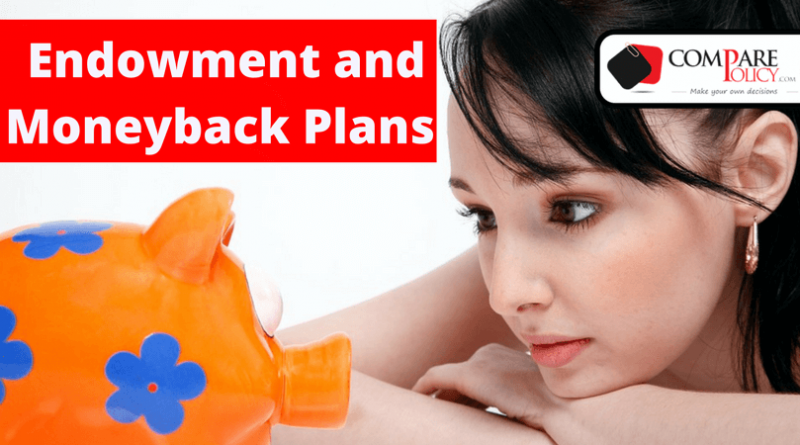What’s Better for Me Endowment or Moneyback
Choosing the right insurance product is always a tough task, as the market is flooded with so many products offered by insurance companies. Mis-selling of products by intermediaries also create confusion about certain products.
When it comes to insurance products, people usually seek to invest with traditional insurance and savings products that would help them accumulate savings to achieve their respective financial goals. Endowment and Moneyback plans are one of the traditional insurance plans that people usually like to opt for, but due to a lot of confusion regarding their returns or policy benefits, they are not able to understand which one would be the most suitable investment option.
In this blog, we are explaining the difference between the Endowment and Moneyback plans.
Both the Endowment plans and Moneyback Plans are a combination of investment and insurance component. Here, the basic difference between the two lies in the time period of receipt of the sum assured.
- Under Endowment Policy, sum assured plus other benefits such as bonuses are payable to the life assured at maturity of the policy, in case he/she survives through the end of the policy term.
- Under Money back Policy, a percentage of the sum assured is payable at regular intervals through the term of the policy. The balance sum assured and bonuses are paid on the maturity.
In case of a death claim, both endowment and money back plans pay the sum assured plus bonuses to the beneficiary.
- Endowment Plans are suitable for buyers who primarily seek savings. By investing with an endowment plan, you can accumulate savings to achieve a financial goal/s, such as child’s marriage or retirement.
- Money back plans are best for insurance buyers, who need a regular flow of funds, so they can meet financial objectives at different phases of life, such as child’s school admission, expenses for higher education, his/her marriage, etc.
As insurance buyers get some portion of the sum assured prior the date of maturity, they have a thinking that the return from money back plan is higher than the endowment plan.
Let’s understand the returns from these two plans with the help of an illustrative example.
Table Content
Endowment Plan
If you buy Tata AIA Life Secure 7 endowment plan to fulfill your medium to long term financial goals, following are the benefits that you can avail under this plan. You at 35 years of age opts to buy this plan with the policy term of 12 years, premium paying term of 7 years, annual premium of Rs 1,54,080 and sum assured is Rs 10 Lacs.
On your Survival till end of the Policy Term
At maturity of the policy, you will receive Guaranteed Sum Assured plus vested Compound Reversionary Bonus plus Terminal Bonus. In total, you will receive Rs 12,89,299 (Rs 10,00,000 + Rs 2,31,439+ Rs 57,860).
On your Death During the Policy Term
In case of an unfortunate demise of the life Insured during the policy term, Sum Assured on death is payable to the nominee along with a vested Compound Reversionary Bonus and Terminal Bonus. Thus, your nominee will receive Rs 20,39,299 (Rs 17,50,000 + + Rs 2,31,439+ Rs 57,860).
Money Back Policy
If you buy Tata AIA Money Back Plus plan to fulfill the different milestones of your life. You at 35 years of age opts to buy this plan with the policy term of 20 years, premium paying term of 10 years, annual premium of Rs 1,16,220 and basic sum assured is Rs 10 Lacs.
On Your Survival till end of the Policy Term
The plan offers survival benefit as a percentage of basic sum assured at regular intervals on the condition that all due premiums are duly paid. Upon choosing 10 year premium paying term, you can receive the following payouts.
20% i.e., Rs 2 Lacs each at the end of the 5th policy year/10th policy year/15th policy year. That means, Rs 6 lacs would be payable up to the end of the 15th policy year.
60% + Vested Bonus at the maturity of the policy, i.e., Rs 10,23,966 (Rs 6,00,000 + Rs 2,56,949 + Rs 1,67,017).
Then, the total survival benefit is Rs 16,23,966.
On Your Death During the Policy Term
In the event of an unfortunate demise of the life insured, the nominee will receive the Death sum assured along with the compound reversionary and terminal bonus. In total, the nominee will receive Rs Rs 15,40,186 (Rs 11,16,220 + Rs 2,56,949 + Rs 1,67,017).
In the event of death due to an accident, an additional amount equal to the basic sum assured is payable to the nominee, i.e., an additional Rs 10 Lacs is payable.
On a comparison,
In the endowment policy, you have invested Rs 15,40,186 and with the money back plan, you have invested Rs 11,16,220. The maturity benefit for endowment plan is Rs 12,89,299 and for moneyback plan is Rs 16,23,966. It implies the returns in a money back plan are higher than an endowment plan. However, returns are not the only criteria to judge the suitability to invest in a plan, you also need to consider other vital aspects such as your risk appetite, liquidity needs and needs for return.
Conclusion
Investing in a money back policy helps you to generate income at regular intervals throughout the policy term, so you can meet some planned expenses. On the other hand, an endowment plan helps you to save a corpus that you will receive at the maturity of the policy. When you are up to choose an endowment or money back plan, it is advisable to firstly assess your investment objective and then choose a plan accordingly. Don’t forget to compare the policy benefits, before buying a policy. It is advisable to read the terms and conditions and invest with a policy that fulfills your financial objectives.

